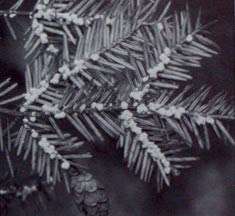
In southern New England and Pennsylvania, the hemlock has been under attack by the hemlock woolly adelgid, Adelges tsugae. There is enough fear of its spreading north that Vermont, New Hampshire and Maine have quarantined hemlock logs and nursery stock from infested areas since 1988. The hemlock woolly adelgid is an aphid-like insect native to Asia that was found in British Columbia in 1922 and had spread to Oregon by 1924. It feeds on all hemlock species but is far and away more deadly to the two eastern species than to the hemlocks out west or to those in Asia. First found in the east in Pennsylvania in the late 1960s, it has advanced erratically, confounding predictions about its long-term impact.
A major increase in its range and in the estimate of the damage it might ultimately cause occurred in September, 1985, after Hurricane Gloria struck and, it is presumed, swept these adelgids across Long Island Sound to Connecticut. In the next few years they spread aggressively, killing both planted eastern hemlocks and those in natural stands.
Mark McClure, an entomologist with the Connecticut Agricultural Experiment Station, began studying the pests in 1985 and is pessimistic about the future of eastern hemlock throughout its range. The adelgids appear to be quite cold hardy and he does not know of a single untreated eastern hemlock tree that recovered after being attacked by the pests. McClure said, "A typical scenario is that trees will die in two to three years after being hit; on an optimal site they can hang on until the fifth or sixth year."
Others point out that although this insect has great destructive potential, in the past it has been fungi, like the chestnut blight and Dutch elm disease, not insects, that have thoroughly devastated tree species. They note that stressed trees, including those in the wide area of Connecticut hammered by Hurricane Gloria, might be making the bug look worse than it really is.
A wide variety of insecticides are effective against this adelgid, but treatment requires a thorough drenching which is not practical in forested situations. McClure believes that successful biological control will depend on introducing an effective predator from Asia and he has imported a mite that preys on the adelgid in Japan. Release of the mite has been approved but it is too soon to tell if it will make a dent in the adelgid's numbers.
Another bit of bad news is that fertilizer, sometimes a help against insect attacks, only increases hemlock's susceptibility to adelgids. According to a study by McClure, twice as many young adelgid nymphs survived on fertilized trees and these went on to produce twice as many eggs per adult. He conjectures that fertilizer encourages soft growth on which the adelgids thrive.
The quarantine has been in place for six years but embargoes are difficult to enforce and adelgid-riddled nursery stock was brought to Vermont in 1990. A few of those adelgids survived one winter, but none has been seen since and it is believed that the insect is not presently in the state.
Ironically, the insects are almost as likely to be hitching a ride on other kinds of logs as they are on hemlock. Deer, chickadees and wind are among the many carriers of these small, light insects.
Hemlock woolly adelgids produce two sizeable generations each year, giving them the potential for extremely rapid population increases. They kill hemlocks by digging in and sucking the trees' sap, but they are mobile for one or two days after hatching from eggs. It is during this time that they are easily dislodged and swept away, possibly landing on new hemlocks.
Though not the most highly valued tree for timber, hemlock thrives on stream banks where it provides vital shade and erosion control. The tree of choice for deeryards, its extremely dense canopy intercepts snow, provides a barrier that limits radiational cooling, and creates a better windbreak than any other species. It would be hard to overstate the importance of eastern hemlock to the well-being of Vermont's forest.

